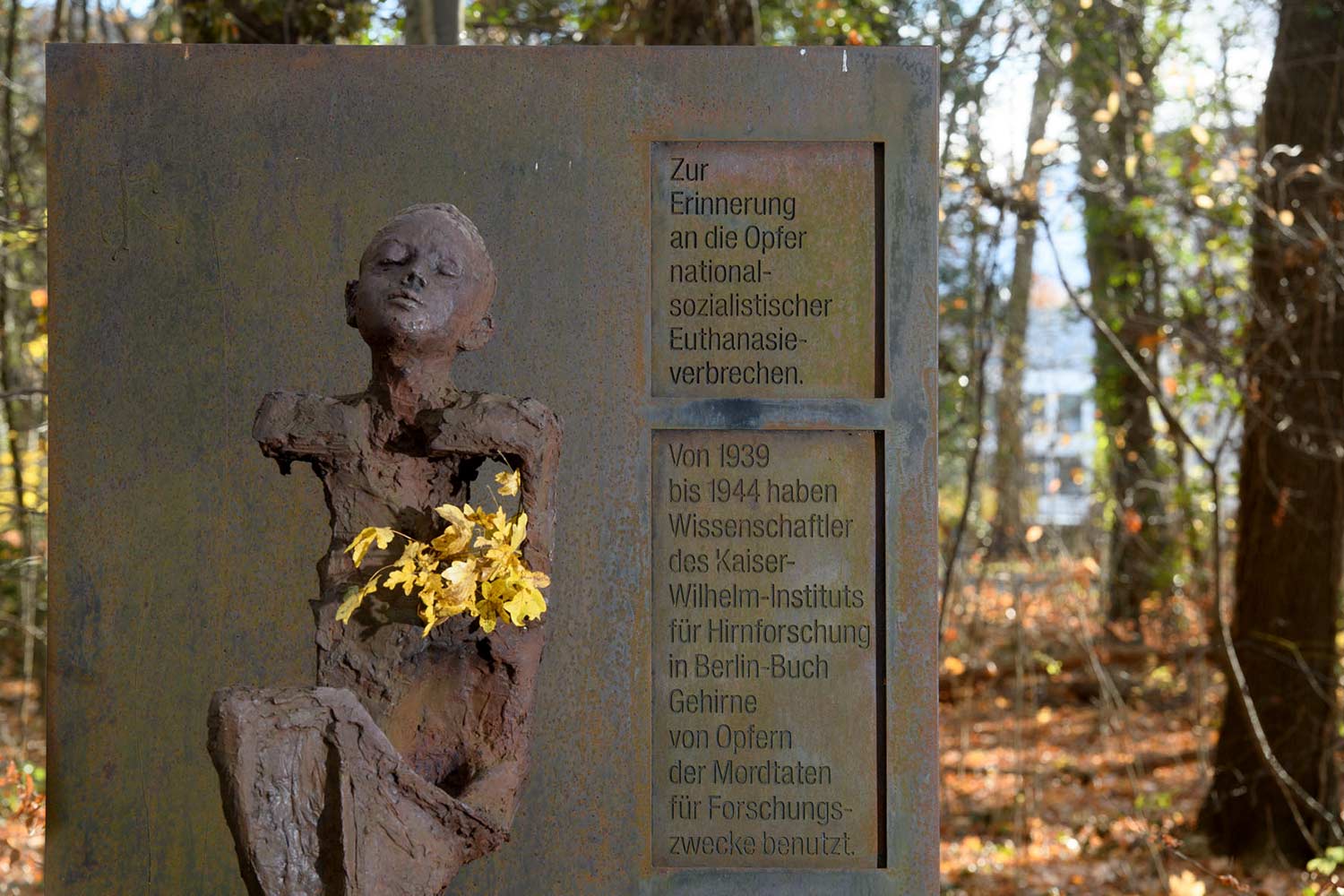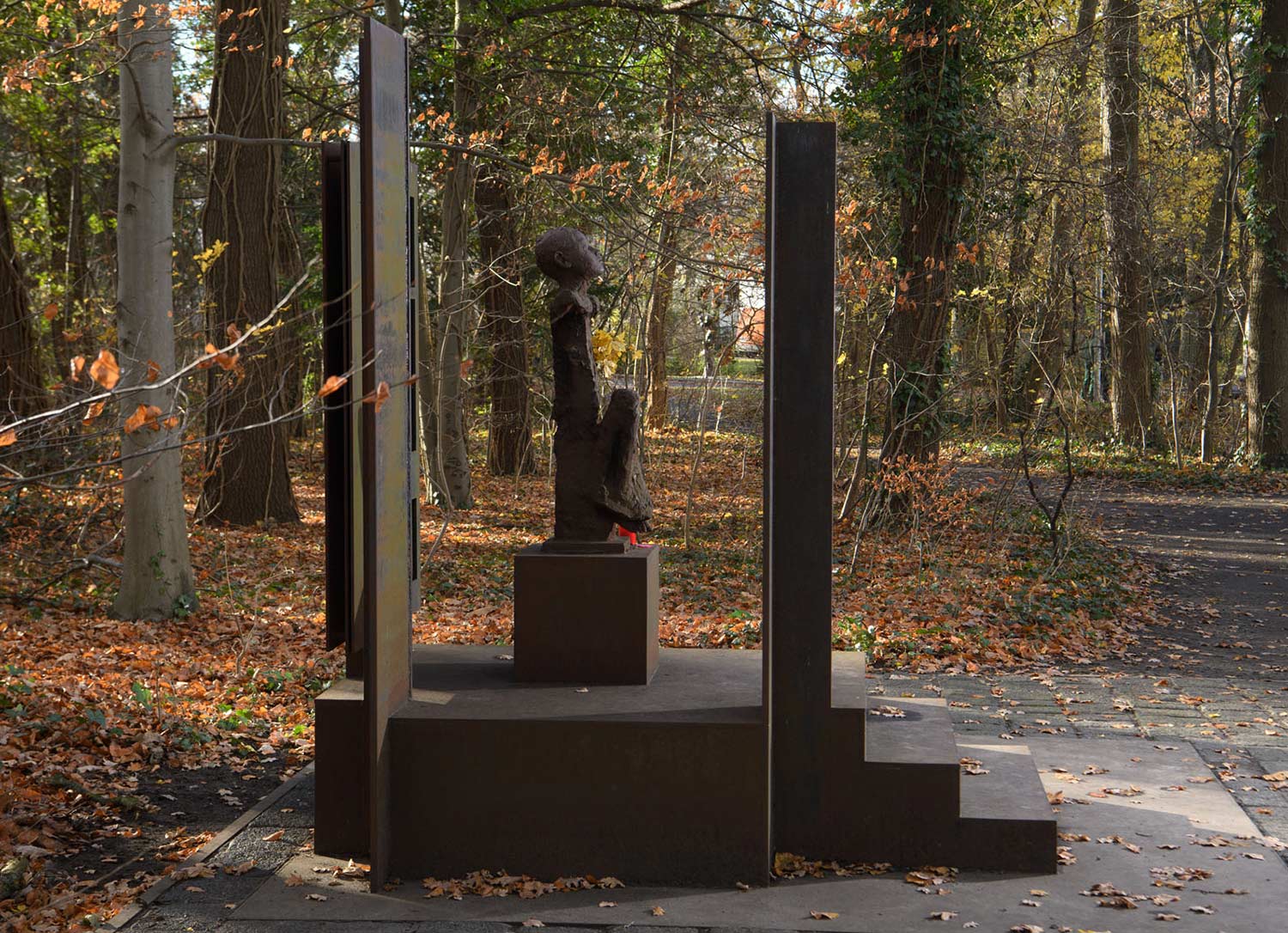13Wenn ich groß bin, dann ...
Anna Franziska Schwarzbach
2000, Cast iron, Copper slag stones

A few meters farther, the path through the woods in the center of the campus brings you to a small clearing. Here stands the memorial, ”Wenn ich groß bin, dann...” (When I grow up, then ...) by the artist Anna Franziska Schwarzbach.
The memorial consists of a metal frame encompassing a seven by seven meter space, where copper slag bricks of various sizes have been used to pave the ground with a relief. This surface supports a metal pedestal with three steps, with another pedestal holding a human figure. Behind this and to the left size, the sculpture is framed by metal steles. The proportions suggest that the figure is a child. The face is recognizable and bears a calm expression. The body, by contrast, is highly abstracted; it seems broken open and the viewer can peer inside. This ”perspective” is only possible from specific positions, however. Metal blocks are positioned opposite the figure as an invitation for the viewer to linger and reflect. From some points of view, the steles near the child form a closed wall; from others they permit a view of the forest.
Anna Franziska Schwarzbach was born in 1949 in Rittersgrün in the Ore mountains. She studied architecture under Prof. Selman Selmanagic at the Conservatory of Art in Berlin-Weissensee. After completing her degree in 1973, she worked as an architect on the Palace of the Republic in Berlin. In 1975 she returned to the conservatory to take night courses in portrait sculpture. She has worked as an independent sculptor since 1977. She uses many materials, and is one of comparatively few female sculptors to work in cast iron. Her pieces have won many awards, can be seen in a large number of exhibitions, and many are on public display. In 1998 she was awarded the Ernst-Rietschel Prize for Sculpture and in 2021 the Brandenburg Art Prize. She is also among the eleven female artists worldwide to have won the Sanford Saltus Prize of the American Numismatic Society in the last 100 years.

The subject of the memorial is the fact that scientists and clinicians of the Kaiser Wilhelm Institute for Brain Research in Berlin-Buch took part in the criminal euthenasia practices carried out under the National Socialist regime. From 1939 – 1944 they carried out research on brains from murdered victims – often children. The brains that were studied in Buch came from sick or handicaped children at the Brandenburg-Görden and other ”health clinics” who were murdered in the name of research. In 1992 the Max Planck Society, the institutional successor of the Kaiser Wilhelm Society, had buried the brain specimens from the Buch institute during a memorial service in Munich. Schwarzbach applied to the newly founded Max Delbrück Center for Molecular Medicine, on the site in Berlin-Buch, to erect a memorial to commemorate the victims. On Oct. 5th, 1992, Prof. Detlev Ganten, who was head of the MDC-foundation board at that time, commissioned her to design a memorial ”based on the proposal she submitted”. Financing was provided by the Culture Fund Foundation and the LOTTO-Stiftung Berlin. The memorial was dedicated on Oct. 14th, 2000, in a ceremony attended by the President of the Max Planck Society, the German Research Foundation, the Helmholtz Association, representatives of the Senate of Berlin, the Mayor of Pankow, several hundred staff and citizens of Buch. It is one of the first memorials to euthanasia erected after German reunification.
The back of the steel structure holds the following inscription:
In memory of the victims of National Socialist euthanasia crimes.
From 1939 to 1944, scientists from the Kaiser Wilhelm Institute for Brain Research in Berlin-Buch used brains of murder victims as the objects of research.
As a duty and reminder for scientists and physicians to act ethically, to respect the inalienable rights of all people and to assume social responsibility for their work.
The site and the arrangement of the piece challenge visitors to confront this history, the crime, the meaning of the terms ”euthanasia” and ”unworthy life”. The placement of the work is appropriate: it stands in the middle of the campus. The memorial is central and should be a constant reminder that scientists must always be aware of the maxims of modern science and act accordingly.
You can find an interview with Anna Franziska Schwarzbach here